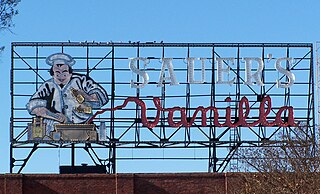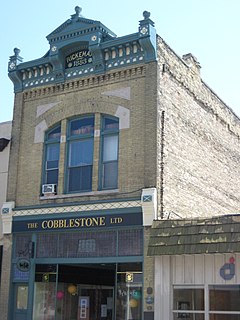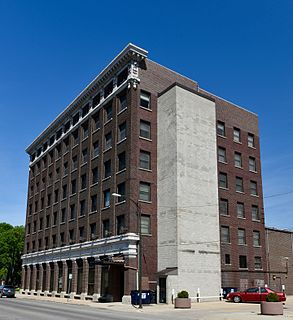
Dealey Plaza is a city park in the West End Historic District of downtown Dallas, Texas. It is sometimes called the "birthplace of Dallas". It also was the location of the assassination of United States President John F. Kennedy, on November 22, 1963; 30 minutes after the shooting, Kennedy died at Parkland Memorial Hospital. The Dealey Plaza Historic District was named a National Historic Landmark on November 22, 1993, the 30th anniversary of the JFK assassination, to preserve Dealey Plaza, street rights-of-way, and buildings and structures by the plaza visible from the assassination site, that have been identified as witness locations or as possible locations for assassin(s).

Brooke Army Medical Center (BAMC) is the United States Army's premier medical institution. Located on Fort Sam Houston, BAMC, a 425-bed Academic Medical Center, is the Department of Defense's largest facility and only Level 1 Trauma Center. BAMC is also home to the Center for the Intrepid, an outpatient rehabilitation facility. The center is composed of ten separate organizations, including community medical clinics, centered around the Army's largest in-patient hospital. BAMC is staffed by more than 8,000 Soldiers, Airmen, Sailors, Civilians, and Contractors providing care to wounded Service Members and the San Antonio Community at-large.

The C.F. Sauer Company is a cooking products business that makes extracts and other food products. It was founded in 1887 by C.F. Sauer in Richmond, Virginia, where it maintains its headquarters.

1 William Street is an office building in the southern portion of the Financial District of Lower Manhattan in New York City. The building has had a number of names, originally the J. & W. Seligman & Company Building, and later the Lehman Brothers Building. Currently it is also known as the Banca Commerciale Italiana Building.

Procter and Gamble Baltimore Plant is a historic factory complex located at Locust Point in Baltimore, Maryland, United States. It is a compact industrial complex built by the national corporation Procter & Gamble comprising five major three-story brick buildings spread over 10 acres (40,000 m2). These major buildings are the Process Building (1929), the Soap Chip Building (1929), the Bar Soap Building (1929), the Warehouse (1929), and the Tide Building (1949).

The Texas Technological College Historic District is a historic district listed on the National Register of Historic Places on the campus of Texas Tech University in Lubbock, Texas. The 110-acre (0.45 km2) district is made up of 27 contributing properties, four non-contributing properties, one contributing structure, one contributing object, and one contributing site.

The Enid Downtown Historic District is a 296-acre (1.20 km2), seven-block district located in Enid, Oklahoma and listed on the National Register of Historic Places since 2007. The district includes the original downtown plat from 1893, part of the Jonesville addition plat from 1898, and part of the Weatherly addition plat from 1902. The district was increased in size in 2019.

The Hawaii Capital Historic District in Honolulu, Hawaii, has been the center of government of Hawaii since 1845.

The Mariscal Mine, also known as the Lindsey Mine and the Ellis Mine, was a source of cinnabar ore that was refined at the Texas site into mercury. The mine is located in what is now Big Bend National Park. The mine produced a total of 1400 flasks of mercury, each weighing 76 pounds (34 kg), accounting for almost a quarter of the mercury production in the United States between 1900 and 1943.

Halifax Historic District is a national historic district located at Halifax, Halifax County, North Carolina, US that was listed on the National Register of Historic Places in 1970 with an increase in 2011. It includes several buildings that are individually listed on the National Register. Halifax was the site of the signing of the Halifax Resolves on April 12, 1776, a set of resolutions of the North Carolina Provincial Congress which led to the United States Declaration of Independence gaining the support of North Carolina's delegates to the Second Continental Congress in that year.

The Rickeman Grocery Building is a historic commercial building located in downtown Racine, Wisconsin. It was constructed in 1883 for grocer George Rickeman. Located on the south side of State Street between College Avenue and Park Avenue, the building contributes to the Historic Sixth Street Business District. The building, an example of the Late Victorian architectural style, was added to the National Register of Historic Places in 1982.

The American Tobacco Historic District is a historic tobacco factory complex and national historic district located in Durham, Durham County, North Carolina. The district encompasses 14 contributing buildings and three contributing structures built by the American Tobacco Company and its predecessors and successors from 1874 to the 1950s. Located in the district is the separately listed Italianate style W. T. Blackwell and Company building. Other notable contributing resources are the Romanesque Revival style Hill Warehouse (1900), Washington Warehouse (1902–07), the Lucky Strike Building (1901–02), and Reed Warehouse; Noell Building ; Power Plant and Engine House (1929–39); and the Art Moderne style Fowler (1939) Strickland (1946) and Crowe (1953) buildings.

Roanoke Rapids Historic District is a national historic district located at Roanoke Rapids, Halifax County, North Carolina. It encompasses 1,130 contributing buildings, 5 contributing sites, 27 contributing structures, and 1 contributing structure in the central business district and surrounding residential sections of the town of Roanoke Rapids. The district includes notable examples of Queen Anne, Colonial Revival, and Bungalow / American Craftsman style architecture. Located in the district is the separately listed Roanoke Rapids High School. Other notable buildings include workers houses in four local mill villages, Driscoll-Piland-Webb House, Dickens-Webb House (1906-1907), Samuel F. Patterson (1914-1915), Council-Coburn House (1925-1927), First Presbyterian Church (1915), All Saints Episcopal Church designed by Hobart Upjohn (1917), (former) First Baptist Church (1928-1929), (former) Nurses Home and School (1930-1931), Clara Hearne Elementary School (1933-1935), (former) North Carolina National Guard Armory (1940-1941), (former) United States Post Office (1937-1938), Rosemary Drug Co. Building (1915-1916), Shelton Hotel, First National Bank Building (1914-1915), J. C. Penney and Co. Building (1938-1942), McCrory Co. Building (1940), Imperial Theatre Building, (former) Seaboard Air Line Passenger Station (1917), Rosemary Manufacturing Company complex, Patterson Mills Co. (1910), and Roanoke Mills Co. Plant No. 2. (1916-1917).

Argos Downtown Historic District is a national historic district located at Argos, Marshall County, Indiana. The district encompasses 21 contributing buildings in the central business district of Argos. It developed between about 1867 and 1942, and includes examples of Italianate, Romanesque Revival, and Neoclassical style architecture. Notable buildings include the Reed Block (1891), Williams Inn (1838), IOOF #263 Hall (1901-1907), Corner Hardware Building (1883), Argos Reflector Building / GAR Hall, Argos Theater, Sarber Building (1892-1898), Old Argos Opera House / Huff Block (1887-1892), Pickerl Block, Argos Municipal Building (1940), Farmers State Bank Block (1917), Argos Masonic Lodge #399 / Grossman Building (1906), Schoonover Building, and Pickerl Residence.

The Mason City Downtown Historic District is a nationally recognized historic district located in Mason City, Iowa, United States. It was listed on the National Register of Historic Places in 2005. At the time of its nomination it contained 93 resources, which included 63 contributing buildings, one contributing site, four objects, 22 non-contributing buildings, and three non-contributing objects. Platted in 1855, Mason City is a commercial and industrial center for north central Iowa. It was also a railroad center, but the tracks bypassed the central business district in order to serve the industries located on the north side of town and the wholesale enterprises on the south side. Central Park, a public square, was part of the city's original plat and is the contributing site.

The Griswold Civic Center Historic District is a small historic district containing eight civic and religious buildings, roughly bounded by Hubbard, Walnut, and Trowbridge Streets, in Allegan, Michigan. It was added to the National Register of Historic Places in 1987.

The Oklahoma Judicial Center is the headquarters of the Oklahoma Supreme Court, the Oklahoma Court of Criminal Appeals, and the Judiciary of Oklahoma. Situated near the Oklahoma State Capitol, the original structure, designed by the architectural firm Layton, Hicks & Forsyth, was built between 1929-1930 as the home of the Oklahoma Historical Society and was listed on the National Register of Historic Places as the Oklahoma Historical Society Building in 1990. The society moved to the nearby Oklahoma History Center when it opened in 2005. An annex was completed in 2011.
Frederick Walter Fitch (1870–1951) was an American businessman who specialized in hair products.




















